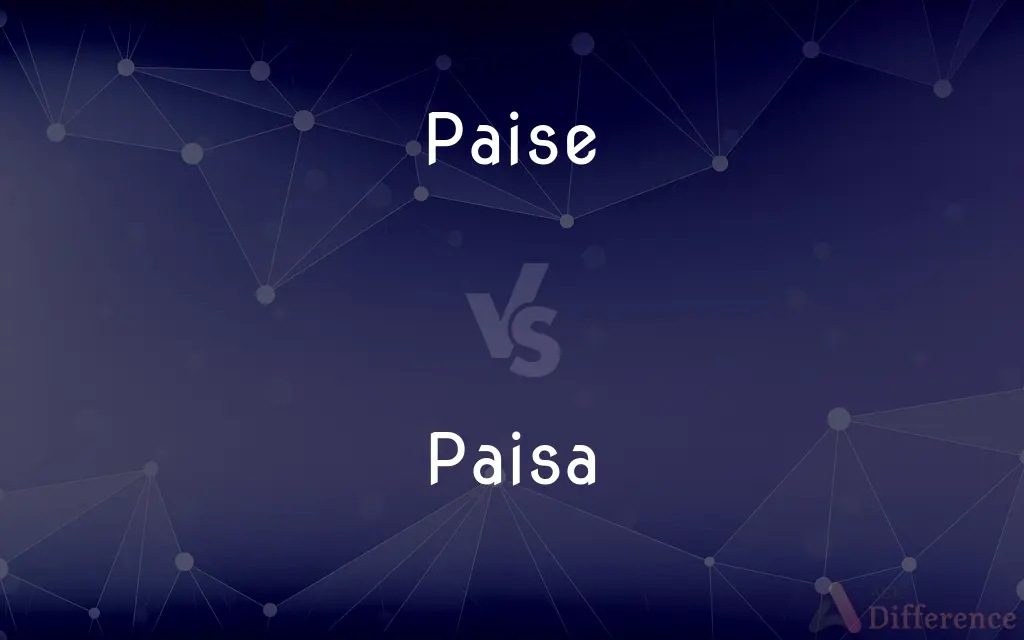Paise vs. Paisa — What's the Difference?
By Urooj Arif & Fiza Rafique — Updated on April 17, 2024
"Paise" refers to the plural form of "paisa," which is a unit of currency used in several South Asian countries.

Difference Between Paise and Paisa
Table of Contents
ADVERTISEMENT
Key Differences
A "paisa" is a single unit of currency, originally a hundredth of a rupee in countries like India and Pakistan. On the other hand, "paise" is simply the plural term, used when referring to more than one paisa.
The term "paisa" is often used in financial transactions and pricing, for instance, something might be priced at 50 paisa. Whereas "paise" would be used when amounts exceed one, such as 50 paise indicating multiple units.
In daily speech, "paisa" might be referenced in common sayings or expressions focusing on the value or cost of items, emphasizing the singularity of the smallest monetary unit. Conversely, "paise" might be used in discussions involving sums or totals, highlighting the collective aspect of the currency.
Historical context plays a role in understanding these terms; the "paisa" was more significant when inflation was lower and could buy more. Today, discussions involving "paise" often relate to larger quantities of this now smaller-value unit.
Linguistically, the transition from "paisa" to "paise" is an example of how languages adapt to number distinctions. This morphological change is crucial for clarity in communication, particularly in financial contexts.
ADVERTISEMENT
Comparison Chart
Definition
Plural form of the currency unit
Singular form of the currency unit
Usage in Speech
Used when referring to multiple units
Used when referring to a single unit
Contextual Use
Discussing totals or sums in pricing and budgets
Pricing individual items or small services
Historical Significance
Reflects cumulative values in modern economies
More valuable in past economies
Linguistic Role
Indicates plural form in grammatical constructions
Demonstrates singular form in languages
Compare with Definitions
Paise
Represents collective monetary amounts.
They collected thousands of paise during the fundraiser.
Paisa
A single unit of currency in South Asian countries.
He donated every last paisa to the charity.
Paise
Used in discussing larger but still small monetary values.
Prices are listed down to the paise.
Paisa
Reflects singular form in linguistic terms.
Add one paisa to the total for rounding off.
Paise
Indicates grammatical plurality in language.
All prices must be calculated in paise, not rupees.
Paisa
Often used to express minimal cost or value.
That old chair isn’t worth a paisa now.
Paise
Plural form, used for multiple units of the currency.
He needs 75 paise to complete a rupee.
Paisa
Symbolically used to represent something very small.
I don’t give a paisa for such trivial concerns.
Paise
Often used in financial calculations.
Sum up all the paise to get the total amount.
Paisa
Historically significant when low-cost items were common.
Back then, a paisa could buy you a candy.
Paise
A unit of currency equal to 1/100 of the rupee in India, Nepal, and Pakistan.
Paisa
The paisa (Hindi: पैसा,Gujarati: પૈસા, Marathi: पैसे, Nepali/Hindi: पैसा, Urdu: پیسہ), poysha (Bengali: পয়সা) or baisa (Omani: بيسة) is a monetary unit in several countries. The word is also a generalised idiom for money and wealth.
Paise
Plural of paisa
Paisa
A unit of currency equal to 1/100 of the rupee in India, Nepal, and Pakistan.
Paise
Obsolete form of poise
Paisa
A subdivision of currency, equal to one hundredth of a rupee in India, Nepal, and Pakistan.
Paise
See Poise.
Paisa
A subdivision of currency, equal to one hundredth of a Bangladeshi taka.
Paisa
A subdivision of currency, equal to one thousandth of an Omani rial.
Paisa
A subdivision of currency equivalent to 64 of a rupee or three pies.
Paisa
(slang) person hailing from the same country
Paisa
A fractional monetary unit in Bangladesh and India and Nepal and Pakistan
Common Curiosities
How has the value of paisa changed over time?
The value of paisa has decreased due to inflation, making it less commonly used in significant financial transactions.
Can the term paisa still be used in financial transactions?
Yes, paisa is still used, particularly in pricing items that cost less than one rupee.
Why is the distinction between paisa and paise important?
Understanding the distinction helps in accurate financial communication and documentation.
Is it common to use paisa in everyday language?
While its practical use in commerce might be diminishing, paisa is still frequently used in colloquial language and expressions.
In what countries is paisa used?
Paisa is used in countries like India, Pakistan, and historically in several other South Asian nations.
What are some common expressions involving paisa?
Expressions like "paisa vasool" (value for money) are common in places like India.
How do businesses handle transactions involving paisa?
Businesses round off amounts to the nearest rupee or keep the exact count in paise where necessary.
What is the difference between paisa and paise?
Paisa is the singular form referring to one unit of currency, while paise is the plural form used for more than one.
How are prices that involve paisa displayed in stores?
Prices are often listed to the exact paisa to reflect the total cost accurately.
Do modern cash transactions frequently involve paisa?
In modern cash transactions, especially in urban areas, dealing with paisa is becoming less common.
What role does paisa play in digital transactions?
In digital transactions, paisa remains relevant for precise accounting and financial representation.
What happens if a price is listed in paisa in a largely cashless society?
In cashless societies, prices listed in paisa are still honored in electronic payments, ensuring precise financial transactions.
Why is understanding paise important for budgeting?
Accurately counting paise is essential for precise budgeting and financial planning, especially in large transactions.
How do electronic payment systems handle paise?
Electronic payment systems account for every paisa, maintaining accuracy in financial transactions and records.
Are there any legal considerations involving paisa?
Legally, every paisa must be accounted for in financial statements and tax documents.
Share Your Discovery

Previous Comparison
Renovate vs. Innovate
Next Comparison
Car vs. AutomobileAuthor Spotlight
Written by
Urooj ArifUrooj is a skilled content writer at Ask Difference, known for her exceptional ability to simplify complex topics into engaging and informative content. With a passion for research and a flair for clear, concise writing, she consistently delivers articles that resonate with our diverse audience.
Co-written by
Fiza RafiqueFiza Rafique is a skilled content writer at AskDifference.com, where she meticulously refines and enhances written pieces. Drawing from her vast editorial expertise, Fiza ensures clarity, accuracy, and precision in every article. Passionate about language, she continually seeks to elevate the quality of content for readers worldwide.
















































